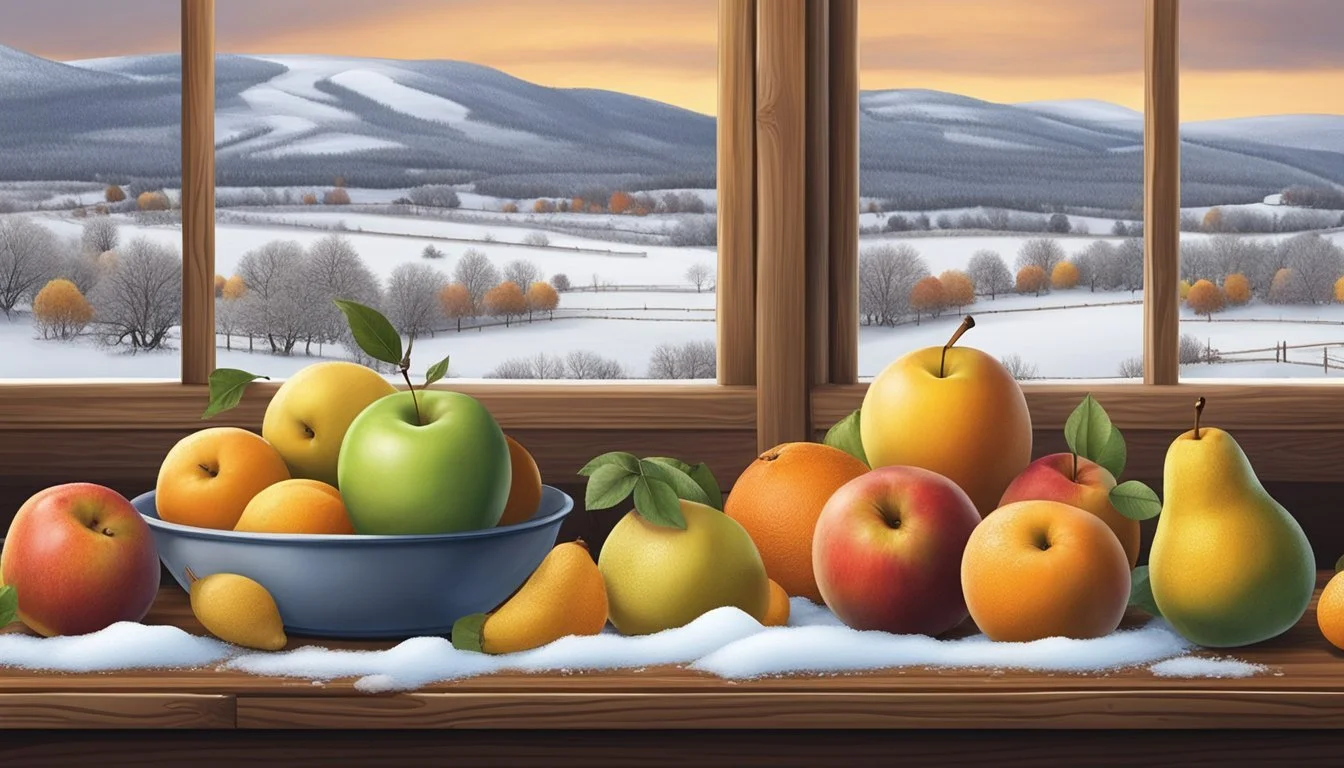South Dakota Seasonal Fruit & Vegetables in January
A Guide to Local Produce
This Article is Part of our South Dakota Seasonal Fruit & Veg Calendar
In South Dakota, January is a time of deep winter, where the landscape is often blanketed in snow and temperatures drop significantly. During this month, the availability of local fresh fruit and vegetables is limited due to the harsh weather conditions. However, that does not mean that all produce is out of reach. There are still opportunities to obtain storage crops and robust winter greens which are capable of surviving colder climates.
Residents and consumers can look for seasonal produce that has been stored from previous harvests or grown in controlled environments, such as greenhouses. These typically include root vegetables, like potatoes and carrots, and winter squash. Additionally, some hearty greens may be available, providing a fresh addition to winter meals. While the fields may not be brimming with a variety of produce as in the summer months, these select fruits and vegetables offer nourishment and flavors that reflect the regional agricultural cycle.
It's important to note that during this time, South Dakota's fresh produce availability aligns with the need for comfort foods and nutrient-dense options to combat the cold. This contributes positively to the notion of eating seasonally and supports the understanding of regional growing patterns and the cyclical nature of agriculture.
Overview of South Dakota's Seasonal Produce
In South Dakota, January is a month characterized by a limited variety of fresh produce due to winter conditions, with a reliance on stored and hardy crops.
Winter Climate and Produce Availability
South Dakota experiences harsh winter weather in January, with cold temperatures that significantly impact what is in season. Locally available produce is typically limited to cold storage vegetables and those that thrive in colder climates.
Understanding Seasonality in Agriculture
Seasonality in agriculture refers to the times of the year when certain fruits and vegetables are at their peak in flavor and nutrition. In South Dakota, the growth and harvest of fresh produce are markedly seasonal, with winter offering a narrower selection.
The Role of State Agriculture
South Dakota's agriculture is crucial in providing food to the state's markets. Even during the winter, local farmers manage to supply some fresh produce, maintaining a level of self-sufficiency and supporting local economies.
Monthly Produce Calendar
Given South Dakota's climate from January to December, a typical calendar for fresh produce availability is skewed towards the warmer months. January's offerings from local farmers include storable crops like potatoes, onions, and beets (how long do beets last?), alongside greenhouses-grown items.
Month Produce January Storage vegetables, greens February Storage vegetables, greens March Storage vegetables, winter greens ... ... December Storage vegetables, winter greens
Nutritional Benefits of Seasonal Eating
Eating seasonally is often associated with better health outcomes. Nutritional benefits are more pronounced in fresh produce, which are richest in vitamins and minerals when consumed in their natural growing season.
Seasonal Fruits in January
January in South Dakota is a time when certain fruits are at their peak for flavor and availability, specifically a variety of citrus fruits, as well as some hardier winter selections.
Citrus Fruits and Storage
Citrus fruits are a bright spot during South Dakota's winter months. Oranges, lemons, and grapefruit are prominent seasonal fruits during January. They offer a burst of flavor and a wealth of vitamin C, which is especially welcome during the colder days.
Oranges: Known for their sweet and tangy flavor, they are available in several varieties and can be stored in a cool, dry place or refrigerated to extend their freshness.
Lemons: With their tart and zesty taste, they are also widely utilized for both their juice and zest in various dishes and can be similarly stored to maintain their quality.
Grapefruit: Yet another citrus option available in January, grapefruit can range from sweet-tart to very sour and is often enjoyed in breakfast settings or as a snack.
Hardy Winter Fruits
Apart from the citrus offerings, some fruits are notable for their ability to withstand the cooler weather. Apples and pears, which were harvested in the fall, remain durable and delicious choices throughout the winter.
Apples: They come in multiple varieties, each with its unique flavor profile, from sweet to tart. Proper storage in a cool place can keep them crisp and flavorful.
Pears: These fruits offer a sweet and slightly floral flavor and should be checked regularly for ripeness, as they can ripen from the inside out. Keeping them in a cool, dark location can help preserve their texture and taste during January.
Seasonal Vegetables in January
January in South Dakota offers a range of seasonal vegetables that are both hearty and flavorful, providing an abundance of options for winter meals.
Cruciferous Vegetables
In January, a variety of cruciferous vegetables are readily available in South Dakota. These nutrient-rich vegetables are known for their distinct flavors and health benefits:
Broccoli: High in vitamins C and K, broccoli adds a crunchy texture to dishes.
Cabbage: With its versatile use in salads, soups, and stews, cabbage is a staple in winter cuisine.
Cauliflower: Its mild flavor makes cauliflower suitable for a variety of culinary applications, from roasting to mashing.
Brussels Sprouts: These tiny cabbages become sweet and caramelized when roasted, enhancing their natural flavors.
Root Vegetables and Tubers
Root vegetables and tubers thrive in the cooler climate and store well, making them ideal for winter consumption:
Potatoes: A classic choice, potatoes are available in several varieties, each with a unique taste and texture.
Carrots: Sweet and crunchy, carrots are versatile in both raw and cooked forms.
Parsnips: Offering a sweet, nutty flavor, parsnips are perfect for roasting or pureeing.
Turnips: With a sharp, slightly spicy taste, turnips can be eaten raw or cooked.
Sweet Potatoes: Packed with flavor and nutrition, sweet potatoes are adaptable to both sweet and savory dishes.
Beets: Earthy and deep-flavored, beets can be roasted, boiled, or eaten raw.
Celery Root: Also known as celeriac, this root adds a mild flavor that is reminiscent of celery.
Leafy Greens and Other Vegetables
January also sees a variety of leafy greens, which are essential for maintaining a balanced diet during the winter months:
Kale: Known for its resilience to cold, kale maintains its texture and rich, earthy flavor when cooked.
Lettuce: Although lighter in comparison to other greens, certain varieties of lettuce can be harvested during the cooler months.
Spinach: Spinach remains a popular choice for its delicate texture and compatibility with many recipes.
Greens: Other hearty greens, which may include collard greens and Swiss chard, also grow well in the cold and add nutritional value to winter meals.
Each of these vegetables offers distinct flavors and nutritional profiles, making them valuable ingredients for creative and healthful winter cooking.
Preparing Seasonal Produce
When handling January's fresh produce in South Dakota, one should pay attention to proper storage, ideal cooking methods, and seasonal recipes to ensure flavor and nutrition are maximized.
Storage and Preservation Tips
To maintain the taste and freshness of January produce, one should consider the following guidelines:
Root vegetables: Store in a cool, dark place with high humidity to prevent wilting.
Winter squash: Keep in a well-ventilated area at room temperature; they can last for several months.
Leafy greens: Store in the refrigerator's crisper drawer; wrap in a damp cloth or in a plastic bag with air holes for longevity.
Apples: Keep in a plastic bag in the fridge away from other produce to avoid ethylene gas accumulation, which can hasten spoilage.
Cooking Techniques and Flavor Pairing
A cook can enhance the natural taste of January's produce with these cooking techniques and flavor pairings:
Roasting: Brings out the natural sweetness in root vegetables like carrots and parsnips.
Steaming: Preserves the color and nutrients of dark leafy greens like kale or Swiss chard.
Sautéing: A quick way to cook spinach or cabbage while retaining texture and flavor.
Pairings:
Sweet flavors of butternut squash (how long does butternut squash last?) complement sage and cinnamon.
Beets pair well with acidic components like goat cheese or citrus to balance their earthiness.
Winter Recipe Ideas
One can create warm and comforting dishes using January's produce. A couple of simple recipe ideas include:
Root Vegetable Stew: A hearty mixture featuring potatoes, turnips, and carrots with herbs and a rich broth.
Apple and Squash Soup: A blend of roasted butternut squash and apples pureed for a smooth, warming soup.
By using these tips, individuals can prepare and enjoy January's seasonal fruits and vegetables in South Dakota with confidence and ease.
South Dakota's Local Food Scene
South Dakota's vibrant local food scene is supported by a network of farmers markets, CSA programs, local food events, and agricultural tourism. These initiatives play a pivotal role in maintaining the state's agricultural economy and providing residents with access to fresh, locally-sourced produce, even in the cooler month of January.
Farmers Markets and Direct Sales
Farmers markets and direct farm sales are crucial conduits between South Dakota farmers and the community. While January in South Dakota is not peak season for fresh produce, some markets and farms offer preserved goods, winter crops, and other local products. These direct sales reinforce the bond between producer and consumer and sustain local agriculture during the colder months.
Winter Products Available:
Preserved jams and jellies
Honey and beeswax products
Root vegetables from storage
Locally crafted goods
Community Supported Agriculture (CSA)
Community Supported Agriculture (CSA) programs in South Dakota continue to function during January, providing a selection of stored or greenhouse-grown produce to their members. Despite the challenges of a harsh winter climate, farmers have adapted, utilizing greenhouses and other growing methods to extend the harvest period.
CSA Features:
Pre-ordered produce boxes
Seasonal selections like squash and root vegetables
Farm fresh eggs
Local meat products
Local Food Programs and Events
The state hosts various local food programs and events to promote South Dakota-grown products. Events such as food conferences not only celebrate the local food scene but also educate participants on the significance of supporting local producers. These programs often highlight seasonal produce and foster community engagement.
Notable Events:
Winter food festivals
Local food conferences
Cooking classes featuring local ingredients
Agricultural Tourism in South Dakota
Agricultural tourism offers an immersive experience for visitors and residents alike. In January, agricultural tourism might include visits to farms for winter activities, tours of food production facilities, or stays in rural bed and breakfasts. Through these tourism offerings, South Dakota showcases its rich farming heritage and rural lifestyle.
Tourism Activities:
Farm stay experiences
Production facility tours
Winter farm events and festivals
Challenges and Considerations
Understanding the unique challenges and considerations of farming in South Dakota during January is crucial for agricultural success and sustainable practices.
Impact of Weather and Climate
The cold weather in South Dakota during January affects both crop choice and production. Few vegetables can withstand the low temperatures, limiting farmers to hardy varieties like storage crops and some greens. Extreme weather events, due to shifting climate patterns, can further stress the agriculture sector, necessitating strategies for climate resilience.
Sustainable Farming Practices
Farmers must consider sustainable practices to maintain soil health and minimize environmental impact. The choice of cover crops, such as mixes of broadleaves and grasses, can enhance soil biological diversity and provide effective weed control. Choosing the right combination can reduce risk and benefit future crop yield and quality.
Economic Factors in Agriculture
The economic viability of farming in the off-season is challenging. Farmers need to balance the costs of production against the market demand for seasonal produce. Economic considerations influence crop selection, with an eye toward crops that provide a reasonable return on investment despite the harsh January conditions.
Future of Seasonal Eating
Seasonal eating trends influence agricultural production. Consumers increasingly seek the health and nutrition benefits associated with eating fresh, in-season produce. Farmers must anticipate these trends to align their crop calendars with market demand, optimizing the health and economic benefits of their produce.







